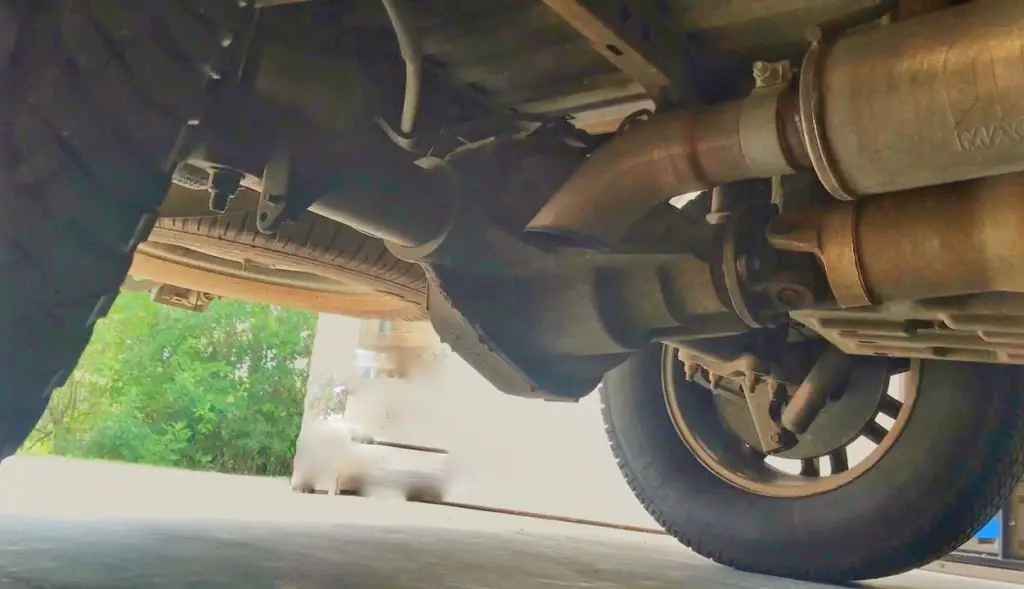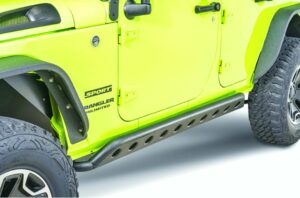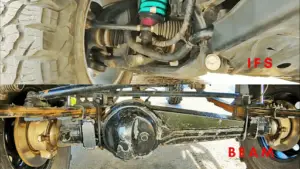Exhaust phase of a vehicle is similar to the expiration phase of a human breathing cycle. If we can’t exhale properly due to obstruction, we can’t inhale properly. Same phenomenon applies to vehicles. If the exhaust system doesn’t function properly, the engine will not function in it’s optimal status.
When it comes to off-roading, the exhaust system is one of the main systems facing abuse while sitting in the bottom of the jeep/truck. That’s where we, as off roaders, have to pay our attention to our exhaust setup.
we have to check what we can do to protect it in off roading terrains as well as how we can improve the exhaust system to get more horses out of it. In this guide let’s look about those aspects.
Contents
What is off-road exhaust?
Off road exhaust is primarily an exhaust that’s street illegal, only for off-road use exhaust, due to not having a catalytic converter.

But now off road exhaust comes with a catalytic converter and they are street legal.
Only difference is these off-road exhaust have relocated the muffler from back to a safer location under the cabin.
Why on road exhaust/norml exhaust will not be much suitable for extreme off roading activities?
If you have ever taken a look under a car/some jeeps, you may have seen that normal exhausts have a muffler located near to the ground and lower than to most of the other under carriage components.
The exhaust tail pipe also sometimes turns to the ground with a bend.
Sometimes the extension pipes also run from the engine to the tailpipe lower in undercarriage, close to the ground.
With such kind of features, there’s a high probability to hit the exhaust system on the ground/ rocks/ logs when trying to crawl over obstacles on off road terrains.
Specially muffler and/ tailpipes are more prone to get hit by obstacles or surfaces while off roading.
The stock placement of the exhaust tailpipe is really not the best place to mount it, because it can easily hit and damage when you need high departure angles.
Another situation is rock crawling. This can most of the time place your jeep/ truck at awkward positions on the rocks,by the belly of the vehicle!!
If your extension pipes, catalytic converters, mufflers haven’t been located in safer places above the frame rails, you are going to damage them.
That can cost you for lots of money to repairing or replacements of the exhaust system.
Another fact is off roading is an activity that demands higher engine powers.
So if you can improve some amount of horse powers from even the exhaust system improvements, why not to get that extra horsepower also.
Benefits of an Off road exhaust
Protection for exhaust systems from trail damages. – A properly positioned exhaust system normally does not hit with obstacles on trails.
Most of the time muffler and tailpipe and sometimes extension pipes, catalytic converters also relocate to more safer places under the chassis.
So even if undercarriage hits the ground, only frame rails will contact with the ground. Exhaust system will be protected without damage.
Can remove horsepower restrictions – As I mentioned at the beginning of this guide, restrictions in the exhaust line can reduce the power of the engine.
So we should be careful whether our exhaust tubes have any restrictions to pass out the gas or not.
Due to economical reasons stock exhaust systems may not be manufactured to give the best out of your engine. With a better aftermarket exhaust system you will be able to get the maximum power your engine can give out.
Improve sound – Sometimes off road vehicles owners are finding better exhaust set up solely for getting an improved mellow and growling sound.
With an off road exhaust system you can get the jeep sound you wish in no time. T
here are different manufacturers out there making different types of exhaust system that can give different tones of sounds to your rig.
Facts to consider when buying exhaust for your off roading vehicle.
It should give improved performance than stock exhaust
as I mentioned earlier stock exhaust may not be the best exhaust to get the max power out of the engine.
Below are few exhaust factors that decide the performance of the engine.
Exhaust pipe diameter should be in perfect size for the relevant engine.
If the diameter is small, exhaust gas will be restricted and power out of the engine will be reduced.
If the diameter is too large, that also leads to power reduction of the engine.
The reason for that is that too large a diameter will break the streamline air flow pattern.
Air tries to be turbulent and reduces the flow rate of the exhaust gas, that leads to reduction of engine performance.
Pipe bending technique
There are different pipe bending techniques. An economical pipe bending technique like crush bending technique can reduce the diameter of the pipe at the bends.
There are other pipe bending techniques that can cost more but they keep the diameter inside the tube uniform at the bends.
Durable material
Exhaust systems can easily damage and rust. So it’s essential to choose a material that lasts long while standing against abuses on trails.
Standard steel can rust easily. It’s better to choose a material like stainless steel for the exhaust system.
Few best off road exhausts for wranglers.
Flow master American thunder cat back

Check Price on Amazon
Magna flow off-road flow series cat back.

Check Price on Amazon
Above exhausts are better off road exhaust for off roaders, who find ways to protect their exhausts from trail damage and get better performance with better sound outcome.
There are many other good off road exhaust manufacturers also. So it’s better to do some research and find what is best for your needs.
DIY method to increase the height of the tailpipe
You can relocate your tailpipe height to a more safer location without replacing the whole exhaust system.
For that you have to cut out the tailpipe after the very end of the muffler and have to readjust the pipe to an upper position.
There is enough space above the tailpipe so this is possible. But you have to be careful, do not raise and relocate the tailpipe near very close to the fuel tank.
Below is a video of how this cheap modification is done to a jeep.
Are there any disadvantages of relocating a shorter tailpipe under the cabin? Yes, there are some disadvantages
you will feel the fuel fumes of the exhaust more.
You are exposed to exhaust gases more than when the tailpipe fits to the back of the jeep.
There are toxic gases coming out through the exhaust pipe. So exposing to those gases for long term may not be good for your health.
More noise and vibration can be felt inside to the cabin with shorter under cabin tailpipes.
Sound of the jeep changed with shorter tail pipes. Some users may don’t like that.
Wrapping up
So far I think you got an idea about what’s an off road exhaust, benefits of using an off road dedicated exhaust and what to look, before choosing an exhaust for your rig.
If you think this guide may be helpful for someone else, you can share this with them. You just have to hit a share button below.
Have fun and safe off roading!!



